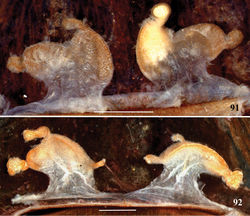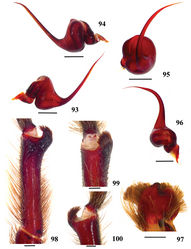Avicularia taunayi
| Notice: | This page is derived from the original publication listed below, whose author(s) should always be credited. Further contributors may edit and improve the content of this page and, consequently, need to be credited as well (see page history). Any assessment of factual correctness requires a careful review of the original article as well as of subsequent contributions.
If you are uncertain whether your planned contribution is correct or not, we suggest that you use the associated discussion page instead of editing the page directly. This page should be cited as follows (rationale):
Citation formats to copy and paste
BibTeX: @article{Fukushima2017ZooKeys, RIS/ Endnote: TY - JOUR Wikipedia/ Citizendium: <ref name="Fukushima2017ZooKeys">{{Citation See also the citation download page at the journal. |
Ordo: ORDO
Familia: FAMILIA
Genus: Avicularia
Name
Avicularia taunayi (Mello-Leitão, 1920) – Wikispecies link – Pensoft Profile
- Anchylochiros taunayi: Petrunkevitch 1939[1]: 291.
- Avicularia taunayi: Raven 1985[2]: 149; Bertani 2012[3]: 78, fig. 176; Bertani and Motta 2013[4]: 108, figs 1–13; World Spider Catalog 2016[5].
Diagnosis
Females of Avicularia taunayi resemble those of Avicularia juruensis and Avicularia variegata stat. n. by the spermathecae with midwidth expanded; about 1.5 times its basal and apical portions widths (Fig. 91). They differ from all these species by the spermathecae with lobes from median to distal portions (Fig. 91). Males of Avicularia taunayi resemble Avicularia avicularia, Avicularia variegata stat. n., Avicularia juruensis, Avicularia rufa, Avicularia purpurea, and Avicularia merianae sp. n. by tibial apophysis on leg I with well-developed base and grouped spiniform setae distally (Fig. 98). They differ from Avicularia purpurea and Avicularia merianae sp. n. by well-developed process on cymbium retrolateral lobe (Fig. 97); from Avicularia avicularia and Avicularia rufa by leg IV as long as leg I and from Avicularia variegata stat. n. and Avicularia juruensis by developed prominence on tegulum (Fig. 95). Additionally, they can be distinguished from all these species by light brown spots extending from the dorsum to lateral region of abdomen (Fig. 103).
Material examined
Female, Brazil, Minas Gerais, Barão de Cocais [19°56'S, 43°28'W], J. P. Couto col., 5 February 1971, ref. 4336 (IBSP 199); male, Brazil, Brasília D.F. [15°46'S, 47°55'W], Gláucia & Reuber col., 14 May 2002 (DZUB 1675).
Additional material
BRAZIL: Pará: Tucuruí [3°46'S, 49°40'W], 1 male, Equipe de Resgate de Fauna col., IBA 285 (IBSP 8570); 1 male, 3 immatures, 27 January 1986 (IBSP ref. 48014); Mato Grosso: Barra do Bugres [15°03'S, 57°10'W], Serra das Araras, 1 juvenile female, C. Strusman col., September 1992 (MCP 2293); Chapada dos Guimarães [15°27'S, 55°45'W], 1 female, M. Acuarensa col., November 1963 (AMNH 1.7); Barra do Tapirapé [10°38'S, 50°36'W] (Barro do Tapirapé [sic]), 2 females, B. Malkin col., 1962 (AMNH 1.5); Goiás: Ipameri [17°43'S, 48°09'W], 1 male, 1 female, F. R. Alves col., February 1996, ref. 78206 (IBSP 14397); Distrito Federal: Brasília [15°47'S, 47°53'W], 1 female, 15 November 2002, F. Brasil leg. (DZUB 1979); Paranoá [15°43'S, 47°44'W], 1 female, 1 immature, R. Bertani, C. S. Fukushima, R. H. Nagahama, P. C. Motta, P. Jotta, 12 July 2007 (DZUB 4707); Sobradinho [Colorado, Córrego do Urubu, 15°42'S, 47°51'W], 1 female, 1 January 1999, J. Marinho-Filho leg. (DZUB 352); Minas Gerais: Santa Vitória [18°51'S, 50°07'W], 1 female, M. Rosa col., 28 July 1981 (ZUEC 018); Monte Alegre de Minas [18°52'S, 48°52'W] (Monte Alegre [sic]), 1 male, A. Lourenço col., June 2005, ref. 95480 (IBSP 12780).
Description, color pattern ontogeny and distribution
See Bertani and Motta (2013)[4].
Complementary description
Spermathecae (Figs 91–92): two completely separated not-twisted long spermathecae, with walls having lobes from median to distal portions and accentuaded outwards curvature medially. Midwidth expanded, about 1.5 times its basal and apical portion widths and weakly-sclerotized area shorter than half the length of well-sclerotized area.
Palp (Fig. 93–96): globous bulb with small subtegulum and developed prominence on tegulum. Embolus: not flattened, lacking keels, 2.62 long in retrolateral view, about 3.0 times tegulum’s length. Medial portion and tegulum’s margin form an acute angle in retrolateral view. Proximal part very curved in frontal view; thin distal width, abruptly narrowing distally; basal, middle, and distal widths 0.42, 0.24, 0.03, respectively. Tegulum: 1.76 long, 0.96 high in retrolateral view. Cymbium subtriangular with subequal lobes, having well-developed rounded process on retrolateral lobe, bearing thick setae (Fig. 97).
Tibial apophysis (Figs 98–100): single branch on prolateral leg I, with well-developed base and grouped spiniform setae distally. Male metatarsus I touches retrolaterally tibial apophysis’ setae when folded.
Type II urticating setae: 0.362–0.407 long, 0.009–0.013 wide in females; 0.840–0.968 long, 0.014–0.020 wide in males.
Color pattern (Figs 102–103): both male and female have long guard-setae on legs and palps not grizzled.
Color pattern ontogeny
Brownish juveniles lacking metallic sheen, black tarsi contrasting with other lighter articles, and abdomen dorsum reddish, with dorsal central longitudinal black stripe connected with first two pairs of transversal black stripes (Fig. 101). When mature, part of the pattern remains (Figs 102–103). Adult females have abdomen with reddish brown guard-setae homogeneously distributed and black short body setae with spots of reddish brown short body setae (Fig. 102). Males have same abdominal pattern as females but reddish brown spots of short body setae are ill-defined (Fig. 103).
Distribution
Brazil, states of Tocantins, Goiás, Pará, São Paulo, Mato Grosso, west of Bahia, Minas Gerais and in Brasília (Distrito Federal), in savannah areas (Fig. 105).
Natural history
A small population of Avicularia taunayi was found at Distrito Federal, in a mountain area that had savannah areas mixed with anthropized areas with houses and farms (Bertani and Motta 2013[4]). Specimens were found in tree holes within retreats similar to the ones made by other species of Avicularia (Fig. 104). This is a unique species of this genus in the bioma Cerrado (savannah) (Bertani and Motta 2013[4]).
Taxon Treatment
- Fukushima, C; Bertani, R; 2017: Taxonomic revision and cladistic analysis of Avicularia Lamarck, 1818 (Araneae, Theraphosidae, Aviculariinae) with description of three new aviculariine genera01 ZooKeys, (659): 1-185. doi
Images
|
Other References
- ↑ Petrunkevitch A (1939) Catalogue of American spiders. Part one. Transactions of the Connecticut Academy of Arts and Sciences 33: 133–338.
- ↑ Raven R (1985) The spider infraorder Mygalomorphae (Araneae): Cladistics and systematics. Bulletin of American Museum of Natural History 182: 1–180. http://digitallibrary.amnh.org/handle/2246/955
- ↑ Bertani R (2012) Revision, cladistic analysis and biogeography of Typhochlaena C. L. Koch, 1850, Pachistopelma Pocock, 1901 and Iridopelma Pocock, 1901 (Araneae, Theraphosidae, Aviculariinae). Zookeys 230: 1–94. https://doi.org/10.3897/zookeys.230.3500
- ↑ 4.0 4.1 4.2 4.3 Bertani R, Motta P (2013) Redescription of Avicularia taunayi and notes on its habitat and geographical distribution (Araneae: Theraphosidae: Aviculariinae). Zoologia 30(1): 107–114. https://doi.org/10.1590/S1984-46702013000100014
- ↑ World Spider Catalog (2016). World Spider Catalog. Natural History Museum Bern http://wsc.nmbe.ch, version 17.5




